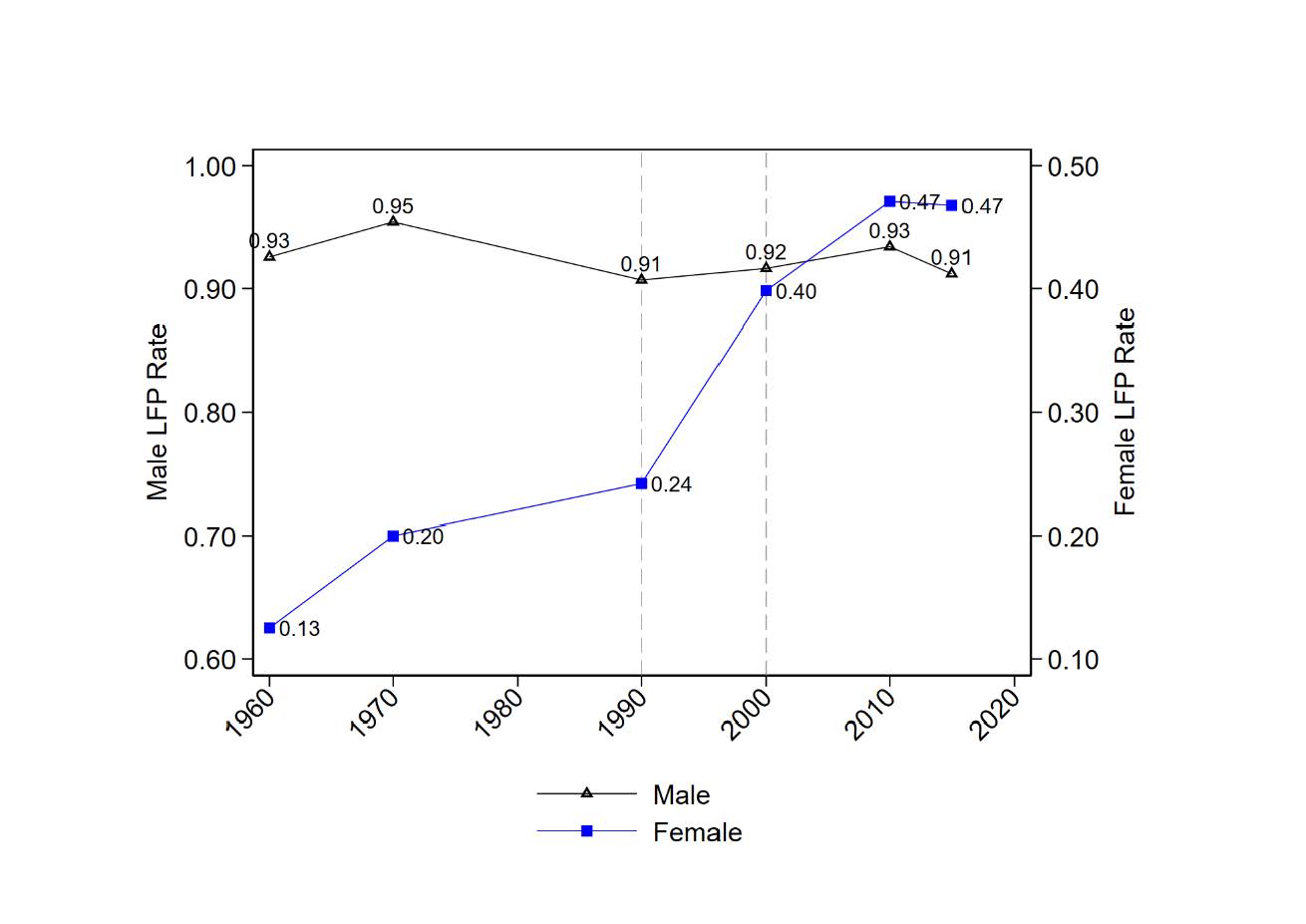Blog
Supply or demand? Exploring the mechanisms behind the rise of female labour force participation in Mexico
At the global level, gender gaps in labour force participation have narrowed and over half a billion women have joined the workforce in the last 30 years. However, there is enormous variation in women's labour force participation (FLFP) across low- and middle-income countries, and there is no clear understanding of why. In a new paper, we investigate the rise of FLFP in Mexico over the last 55 years, with a view to illuminating the relative importance of supply and demand mechanisms in this increase. The speed and timing of the rise in FLFP, as well as the availability of abundant high-quality sources of data, make Mexico a good setting for the purposes of this research.
Growth of FLFP over this period is S-shaped, exhibiting an acceleration during the 1990s (see Figure 1). A similar S-shaped evolution of women’s labour supply has been documented for the United States. In Mexico, there was a gradual increase between 1960–90, averaging 3.7 percentage points (pp) per decade. During 1990–2000, this accelerated to 16 pp. In the period 2000–15, the growth rate reverted to 3.7 pp.
FLFP growth in the 1990s was among the largest of decadal increases in the world, as the number of women working in Mexico increased from 24% to 40%, marking a proportional increase of 66% among women of prime working age. This increase was pervasive across the age distribution and includes married women. It was also evident among both high school and university graduates, though the increase was larger in absolute and proportional terms among high school graduates.
Figure 1: Labour force participation rate by year and sex

Using decomposition methods and a shift-share approach, we exploit both individual and spatial variation across 2,331 municipalities of Mexico to quantify the relative importance of key factors behind FLFP growth. On the labour supply side, we consider education, fertility, and marital status. On the labour demand side, we focus on changes in the sectoral and occupational composition of employment.
Sectoral shifts are a marker of structural change, in particular shifts in workforce composition from agriculture to goods and service industries have commonly been associated with increases in the demand for women’s labour. Changes in occupational structure reflecting non-neutral technological change and changing skill requirements in the economy have also tended to favour women in many settings (see Acemoglu and Autor 2011; Blau and Kahn 1997; Black and Spitz-Oener 2010; Juhn et al. 2014; and Deming 2017).
The factors that increased women's employment
We show that these supply and demand factors can account for FLFP growth in Mexico over the period considered, led by increases in women's education and shifts in the occupational structure of the workforce. Together, just the three supply-side determinants account for 73% of FLFP growth between 1960–2015, with increased education alone accounting for 45.7%, and reduced fertility rates accounting for another 11%. On the demand side, changes in sectoral composition have no explanatory power, but changes in occupational composition can explain about 40% of the increase in FLFP.
However, as much as 40% of FLFP growth in the 1990s, when female labour supply spiked, remains unexplained. Most of the variables considered in our analysis follow secular trends that do not exhibit sharp changes over this or any other subperiod, so changes in workforce composition alone are unable to explain the acceleration of the 1990s. The same applies when we look at returns to individual characteristics and estimated measures of labour demand across occupations and sectors.
One potential explanation might be related to changes in social norms around women's work, a factor that is difficult to measure, but that the literature has pointed to (see Fernández et al. 2004; Goldin 2006; and Fernández 2013). A paper by Fogli and Veldkamp (2011) even suggests that, under certain circumstances, information transmission across generations could give rise to periods of accelerated FLFP. This is an interesting area for future research.
FLFP in Mexico remains low by international standards, even when compared to other Latin American countries. Substantial gains have been made since the 1960s, but there is much more that needs to be done to bring women into the workforce. More than half of prime-age women remain outside the labour market, the larger share of whom are women without a degree. The incentives for these women to join the labour force are blunted by low wages.
Between 1990–2015, real wages in Mexico have fallen on average and more so for low-skilled women than for low-skilled men, leading to a widening of the gender pay gap at the bottom of the distribution, even while it narrowed in the upper regions of the distribution. The position of low-skilled women in Mexico has further deteriorated since the onset of the coronavirus pandemic, with almost two-thirds of job losses having been incurred by women, primarily lower-income women.
The views expressed in this piece are those of the author(s), and do not necessarily reflect the views of the Institute or the United Nations University, nor the programme/project donors.
 Join the network
Join the network




